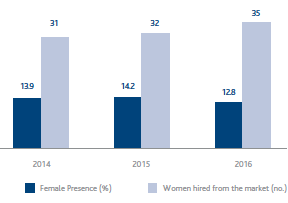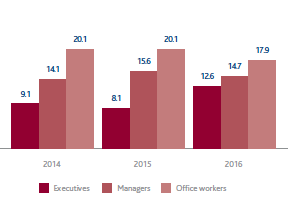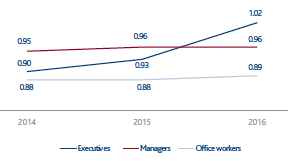Development of human capital
Employment in times of change (GRI: G4-LA1,LA2,LA12)
To continue to play a key role within a dynamic environment while continuing to lead in an international market abundant in challenges and opportunities, it is necessary to become an integrated player capable of enhancing know-how and meeting new challenges in the regulated and free market alike.
The new organisational structure helps everyone to collaborate by sharing experiences and skills and through teamwork to reach a single objective: all decisive factors to create innovation and bring value to the business.
The strong sense of belonging to the Group, which was also revealed by the results of the 2016 company climate analysis, makes it possible to actively engage all employees in continuous improvement, which is increasingly driven by an entrepreneurial spirit, simplification and implementation capacity.
At 31 December 2016, out of a total of 2,883 employees, approximately 93% of Snam personnel have permanent employment contracts (Including part-time contracts). The average age of Group employees is 46.1, while the average length of employment is around 21 years. As it has done every year, again in 2016 Snam recognised its employees who have dedicated 25 years to the company. Those who reached this milestone received a gold medal and fuel vouchers to commemorate this important event and their individual contribution to the Company’s growth. Of the 126 people recognised: 18 were employees of Snam, 105 of Snam Rete Gas and 3 of Stogit.
| Download XLS (16 kB) |
|
2014 |
2015 (*) |
2016 |
||
|
|||||
Executives |
99 |
99 |
87 |
||
Managers |
447 |
449 |
421 |
||
Office workers |
1,689 |
1,736 |
1,651 |
||
Manual workers |
713 |
721 |
724 |
||
Total Employees |
2,948 |
3,005 |
2,883 |
||
| Download XLS (16 kB) |
|
2014 |
2015 |
2016 |
Permanent contract |
2,713 |
2,779 |
2,631 |
Apprenticeship or internship contract |
178 |
171 |
206 |
Fixed-term contract |
|
1 |
1 |
Part-time contract |
57 |
54 |
45 |
| Download XLS (16 kB) |
|
2014 |
2015 |
2016 |
Hired from the market (total) |
152 |
162 |
141 |
- of which university graduates |
74 |
75 |
73 |
- of which school graduates |
78 |
86 |
66 |
- of which women |
31 |
32 |
35 |
Other new employees (non-consolidated companies, tender acquisitions, etc.) |
6 |
4 |
36 |
DEMOGRAPHIC DIVERSITY: EMPLOYEES PER AGE BRACKET (NO.)
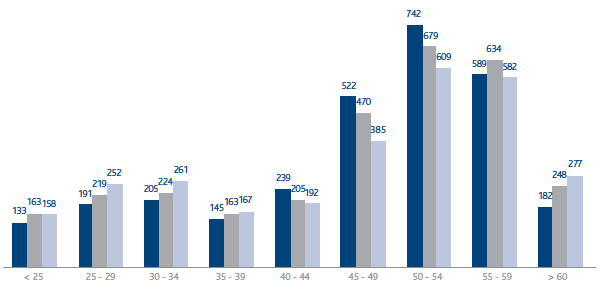
STAFF TURNOVER (%)
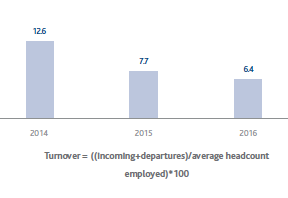
ABSENTEEISM RATE (%) (*)
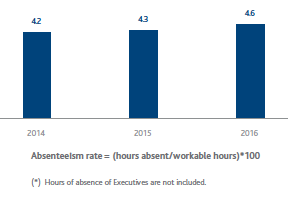
Development of roles and skills (GRI: G4-LA11)
The compensation systems are periodically updated based on a comparison with the reference pay markets and criteria inspired by meritocracy and internal equity, as well as in consideration of indications received from external stakeholders. In particular, these systems are meant to ensure recognition of the results achieved, a link with shareholder interests, the quality of the professional contribution provided and individual development potential.
Again in 2016, the competitive positioning and equity of pay policies was verified and optimised for managers and professionals, and the use of the new target assignment and evaluation system, Performance Management, was confirmed, which also contains targets regarding behavioural aspects, sustainability and workplace accident prevention.
All jobs within Snam, Snam Rete Gas, GNL Italia and Stogit are subject to an analytical and overall evaluation of Complexity, Responsibility, Experience and Autonomy (CREA) factors. In 2016, 278 CREA assessments were approved. All assessment processes adopted are formalised and include a feedback interview, which constitutes an institutional moment for exchange and communication between the manager and the employee, also in order to gather information that can be used to define new actions for the development and enhancement of people.
Professional enhancement (GRI: G4-LA9,LA10,SO4)
Training is another essential element for supporting the processes of organisational integration and change management, and for enriching the employment opportunities of Snam personnel.
In 2016, a total of 82,184 hours of training were provided (an average of 28.5 hours per employee), with 10,396 participants and a participation rate of 97.5%, testimony to Snam’s ongoing and wide-reaching commitment to updating and developing its employees’ expertise.
In 2016, training also included differentiated courses targeted to meet specific needs, based on a segmentation of the company population horizontally, by role and professional family, as well as vertically, by level of responsibility.
Technical training for gas operators and technicians continued, to ensure that they maintain their specialised know-how, including by inviting internal experts to act as instructors and providing courses at the regional offices.
A significant commitment was dedicated to worker training programmes regarding sensitive issues such as health, safety and the environment, by organising a number of meetings to provide updates and information and raise awareness amongst all professional figures with respect to the implementation of safety measures.
To favour accurate information and the application of the principles set forth in the Model 231, the Code of Ethics and Anti-corruption legislation, specific training activities were carried out for specific segments of the company’s workforce.
As regards training on the Code of Ethics, Model 231 and anti-corruption, a total of 2,641 hours of training were provided to 1,596 participants in 2016.
| Download XLS (16 kB) |
|
2014 |
2015 |
2016 |
Executives |
4,442 |
2,744 |
2,940 |
Managers |
11,141 |
11,143 |
10,021 |
Office workers |
41,441 |
41,763 |
31,072 |
Manual workers |
25,434 |
31,970 |
38,151 |
Total |
82,458 |
87,620 |
82,184 |
| Download XLS (16 kB) |
Description |
Hours provided |
Participants |
Recipients |
Management Training |
8,674 |
833 |
High Flyers, Executives, Managers |
Training dedicated to plant maintenance and knowledge of technical systems |
43,281 |
4,103 |
Technicians, office workers and manual workers |
Foreign languages |
8,300 |
380 |
Executives, managers, office workers and technicians |
Health, safety, environment and quality |
19,288 |
3,484 |
Executives, managers, office workers and technicians |
Updating of Model 231 and the Code of Ethics |
2,641 |
1,596 |
Executives, managers, office workers and technicians |
Evolution of corporate welfare
Snam interprets corporate welfare as a way of creating value for its people by seeking a better work/life balance.
To achieve the objective of increasingly meeting the real needs of individuals, investigations into the company population and the services provided were conducted in order to gather feedback through questionnaires, focus groups and detailed climate analyses.
The resulting Welfare Project is a new system designed to be a mix of tradition and innovation, following three guidelines: introduce new initiatives for emerging needs; draw up specific measures based on the needs of the Company’s various employees and ensure that employees are aware, informed and involved.
Early February 2016 saw the launch of SnamMY, the new Snam Group Welfare portal, accessible from anywhere and from any device. This is just one of the company’s many initiatives meant to improve communication between the company and its people, in addition to work-life balance.
In line with the new welfare model, SnamMY features a panel of services currently organised around four areas: “family”, “health and well-being”, “personal time” and “saving”.
One of the most significant outcomes in terms of perceived value has been the launch of the ‘smart working’ experiment. The experiment, which is currently limited to certain Snam departments, will be concluded in 2017 and, following analysis of the results, may be extended to all Group companies.
Diversity (GRI: G4-LA9-LA12-LA13)
Snam respects everyone’s dignity, and offers equal opportunities throughout all phases and for all aspects of the employment relationship, avoiding all forms of discrimination based on sex, age, health, nationality, political opinion or religious views. The Group employs 130 disabled people, whose path of development aims to favour their inclusion and integration in company processes.
One of the most significant impacts of the corporate welfare ethos can be seen in the rising proportion of female employees, whose presence within the Company has historically been a small one, due partly to the nature of the work involved.
In 2016, 25% of new hires were women, whose proportion of the corporate population as a whole amounts to 12.8%. Women account for 14.7% of managers and 12.6% of executives, with three of the four new executives appointed in 2016 being female.
The overall decrease in women at Snam (12.8% compared with 14.2% in 2015) can be attributed to the spin-off of distribution activities. The transfer of roles from Snam to Italgas also involved the transfer of 87 women who worked for Snam in 2015.
| Download XLS (16 kB) |
|
2014 |
2015 |
2016 |
Average hours of training provided to men (hours/year) |
29.1 |
30.9 |
30.2 |
Average hours of training provided to women (hours/year) |
20.9 |
18.4 |
17.0 |
FEMALE PRESENCE, TOTAL AND BY ROLE (%)
Female presence
Female presence by role (%)
